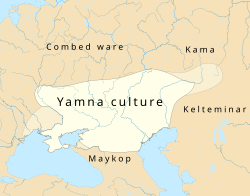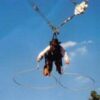History of Ukraine
![]()
History of Ukraine
54 languages
Tools
From Wikipedia, the free encyclopedia
| The neutrality of this article is disputed. Relevant discussion may be found on the talk page. Please do not remove this message until conditions to do so are met. (April 2025) (Learn how and when to remove this message) |
The history of Ukraine spans thousands of years, tracing its roots to the Pontic steppe—one of the key centers of the Chalcolithic and Bronze Ages, Indo-European migrations, and early horse domestication. In antiquity, the region was home to the Scythians, followed by the gradual expansion of Slavic tribes. The northern Black Sea coast saw the influence of Greek and Roman colonies, leaving a lasting cultural legacy. Over time, these diverse influences contributed to the development of early political and cultural structures.[1][2][3]
Ukraine enters into written history with the establishment of the medieval state of Kievan Rus’. In Dnieper Ukraine, the tribe of Polans played a key role in the formation of the state, adopting the name Rus’ by the 9th century. The term is believed to have connections to the Varangians, who contributed to the state’s early political and military structure.[4][5][6] By the 10th–11th centuries, Kievan Rus’ had grown into one of the most powerful and culturally advanced states in Europe, reaching its golden age under Volodymyr the Great and Yaroslav the Wise, who introduced Christianity and strengthened political institutions. However, internal conflicts among Kyivan rulers, along with increasing pressure from Turkic nomads in Southern Ukraine, gradually weakened the state.[7]
In the 13th century, Kievan Rus’ suffered devastating destruction during the Mongol invasion, particularly in its Dnieper heartlands. While much of its former territory fell under Mongol control, the Kingdom of Ruthenia (Galicia-Volhynia) emerged as a major center that preserved political and cultural traditions of Rus’, especially under King Daniel.[8] Despite continued Mongol dominance in the region, the kingdom retained a degree of autonomy and became a vital repository of Rus’ heritage. However, over the subsequent centuries, shifting regional power dynamics gradually transformed the political landscape.[9]
In the 14th and 15th centuries, the majority of Ukrainian territories became part of Grand Duchy of Lithuania, Ruthenia and Samogitia, while Galicia and Transcarpathia came under Polish and Hungarian rule. Lithuania kept the local Ruthenian traditions, and was gradually influenced by Ruthenian language, law and culture, until Lithuania itself came under Polish influence, following the Union of Krewo and Union of Lublin, resulting in two countries merging into Polish-Lithuanian Commonwealth, leaving Ukrainian lands under the dominance of Polish crown.[10] Meanwhile Southern Ukraine was dominated by Golden Horde and then Crimean Khanate, which came under protection of the Ottoman Empire, major regional power in and around Black Sea, which also had some of its own directly-administrated areas as well.[11]
In the 17th century, the Cossack rebellion led by Bohdan Khmelnytsky marked a turning point in Ukraine’s history. The uprising, which began in 1648, was fueled by grievances against the Polish-Lithuanian Commonwealth‘s nobility, religious tensions, and social inequalities. This rebellion led to the creation of the Cossack Hetmanate, a semi-autonomous polity in central and eastern Ukraine. In 1654, the Cossack Hetmanate allied with the Tsardom of Moscow through the Pereiaslav Agreement. The nature of this alliance has been widely debated by historians. Some argue that it established a protectorate relationship, with Russia offering military support in exchange for loyalty, while others believe it symbolized the subordination of the Hetmanate to the Tsar. The ambiguity of the treaty’s terms and differing interpretations contributed to tensions over the following decades.[12] Over time, the relationship between the Cossack Hetmanate and Russia evolved, with Russia increasingly asserting dominance. This process intensified in the late 17th and 18th centuries, especially after the Truce of Andrusovo, which divided Ukraine between the Polish-Lithuanian Commonwealth and Russia.[13]
The Cossack Hetmanate‘s autonomy was progressively eroded, culminating in its abolition by Catherine the Great in the late 18th century. Simultaneously, the Polish-Lithuanian Commonwealth’s internal decline and external pressures from neighboring powers facilitated the partitions of Poland. These partitions allowed the Russian Empire to incorporate vast Ukrainian territories, including those previously under Polish control. Western Ukraine, however, came under the rule of the Habsburg monarchy. This division set the stage for the different historical trajectories of Ukrainian lands under Russian and Austrian influence.[14]: 199
The 20th century began with a renewed struggle for Ukrainian statehood. Following the collapse of empires during World War I, the Ukrainian People’s Republic (UPR) was proclaimed in 1917 with Kyiv as its capital. Meanwhile, in the western territories, the West Ukrainian People’s Republic (WUPR) was established in 1918, centered in Lviv. Both republics sought to unite, forming the Unification Act (Act Zluky) on 22 January 1919.[15] However, their independence was short-lived. The UPR faced constant military conflict with Bolshevik forces, Poland, and White Army factions. By 1921, following the Soviet-Ukrainian War, Ukrainian lands were divided: the eastern territories became the Ukrainian Soviet Socialist Republic (part of the USSR), while western Ukraine was absorbed by Poland, Romania, and Czechoslovakia.[14]: 537
Under Soviet rule, initial policies of Ukrainianization gave way to oppressive Russification. The Holodomor famine of 1932–1933, a man-made disaster, caused the deaths of 4-5 millions Ukrainians.[16]: §§ 8.1.3 During World War II, Ukraine endured brutal occupations by both Nazi Germany and the Soviet Union. The Ukrainian Insurgent Army (UPA) fought for independence, though parts of Ukrainian society also collaborated with occupying forces. Post-war, Soviet control was reestablished, and Crimea was transferred to Ukraine in 1954.
Ukraine became independent when the Soviet Union dissolved in 1991. This started a period of transition to a market economy, in which Ukraine suffered an eight-year recession.[17] Subsequently however, the economy experienced a high increase in GDP growth until it plunged during the 2008–2009 Ukrainian financial crisis.[18] This period was marked by economic challenges, the rise of nationalism, and growing tensions with Russian Federation. In 2013, the Euromaidan protests began in response to President Viktor Yanukovych‘s rejection of an EU association agreement. The Revolution of Dignity followed, leading to Yanukovych’s ousting. Russia annexed Crimea in 2014 and supported separatist movements in Donbas, initiating the ongoing Russo-Ukrainian War. This escalated on 24 February 2022, with Russia’s full-scale invasion, marking a critical phase in Ukraine’s fight for sovereignty and territorial integrity.
Prehistory
[edit]
Paleolithic and Mesolithic Age
[edit]
See also: Ukrainian stone stelae

The discovery of 1.4-million-year-old stone tools in Korolevo, located in western Ukraine, marks one of the earliest securely dated presences of hominins in Europe. These tools offer crucial insights into the behaviors and adaptive strategies of early members of the genus Homo, likely Homo erectus, as they expanded into the continent during the Lower Paleolithic period.[19] The Neanderthal presence in Ukraine is well-documented through archaeological findings, particularly at the Molodova sites, which are located in the modern-day Chernivtsi region in southwestern Ukraine. These sites, dating to the Middle Paleolithic period (c. 45000 – c. 43000 BC), provide significant evidence of Neanderthal activity. Molodova is known for its rich cultural layers attributed to the Mousterian tradition, showcasing the use of fire, mammoth bone processing, and possible construction of primitive shelters.[20] These sites, located along the Dniester River, are particularly notable for their evidence of advanced behavior. One remarkable feature is the discovery of a dwelling constructed from mammoth bones, a testament to Neanderthal ingenuity and adaptation to harsh Ice Age environments. These structures highlight their ability to organize resources and create durable shelters.[21][22]
The Crimean Mountains hold significant evidence of early modern humans (Homo sapiens) during the Upper Paleolithic period. The Buran-Kaya cave sites have yielded artifacts, such as tools and ornaments, along with skeletal remains, dating to approximately 32,000 BC. These Gravettian settlements reflect a sophisticated hunter-gatherer culture, known for their blade-based lithic technologies and artistic expression. The region likely served as a vital hub for human activity, offering both shelter and access to diverse ecological resources.[23] The archaeological record in Ukraine highlights the area’s importance as a crossroads for early human populations migrating through Europe. From the earliest stone tools to evidence of complex social structures and artistic traditions, Ukraine offers a valuable lens into the evolution and adaptation of early humans over hundreds of thousands of years.
Neolithic and Bronze Age
[edit]
Main articles: Cucuteni–Trypillia culture, Sredny Stog culture, Yamna culture, and Catacomb culture

The Cucuteni–Trypillia culture (c. 5050 – c. 2950 BC), centered in modern-day Romania, Moldova, and Ukraine, represents one of the most advanced Neolithic civilizations in Europe. These people were known for their impressive settlements, some of which were among the largest in the world at the time, with populations reaching up to 10,000 inhabitants. They built concentric layouts of houses, often using clay and wood, demonstrating advanced planning. They are renowned for their intricate painted ceramics, featuring geometric and symbolic designs in red, black, and white. Their economy was primarily agrarian, complemented by animal husbandry and small-scale trade. Archaeological findings suggest a focus on fertility cults, as evidenced by numerous figurines and symbolic artifacts. The Cucuteni–Trypillia culture began to decline around 3000 BC, possibly due to environmental changes, resource depletion, or pressures from neighboring steppe cultures.[24]
The Sredny Stog culture (c. 4500 – c. 3500 BC) emerged to the east of the Cucuteni–Trypillian zone, on the Pontic–Caspian steppe. It marked a transitional phase between the Neolithic and the emergence of the early Bronze Age steppe cultures. This culture is among the earliest to show evidence of horse domestication, which became a defining feature of steppe societies. Early indications of mound burial (kurgans) began to appear, reflecting evolving social hierarchies and ritual practices. The Sredny Stog culture played a significant role in the genesis of the later Yamna culture.[25]

The Yamna culture (c. 3300 – c. 2600 BC), also known as the Pit Grave culture, was a dominant force in the early Bronze Age across the Pontic–Caspian steppe. This culture is often linked with the spread of Indo-European languages and reflects a shift toward a more mobile, pastoralist lifestyle. The Yamna culture is characterized by its kurgans, often accompanied by grave goods such as weapons, ornaments, and animal sacrifices. The economy relied heavily on livestock, including sheep, cattle, and horses, which supported a semi-nomadic lifestyle. They utilized copper and bronze tools and weapons, demonstrating early metallurgical skills. Many scholars associate the Yamna culture with Proto-Indo-European speakers, as their migrations and cultural diffusion likely influenced vast areas of Europe and Asia.[26]
Following the Yamna culture, the Catacomb culture (c. 2500 – c. 1950 BC) emerged, encompassing much of the same geographic area. It is distinguished by its unique burial practices, where bodies were interred in specially carved niches within grave pits. They further advanced bronze metallurgy, producing a variety of tools, weapons, and ornaments. The Catacomb culture maintained many traditions of the Yamna culture while also interacting with neighboring groups to the west and south.[27]
- Cucuteni-Typillia ceramic vessel (National Museum of the History of Ukraine, Kyiv, Ukraine)
- Yamna stone stele, c. 2600 BC


































![Lieutenant-Colonel Robert Rogers (7 November 1731 – 18 May 1795) was a British Army officer and frontiersman. Born in Methuen, Massachusetts, he fought in King George’s War, the French and Indian War and the American Revolutionary War. During the French and Indian War, Rogers raised and commanded Rogers’ Rangers, a ranger unit trained for carrying out asymmetric warfare.[2][3](https://www.cowboyron.com/wp-content/uploads/2022/05/1262463_580743685323360_2133853937_o1-1-150x150.jpg)

















![Billie Joe Armstrong & Norah Jones – Silver Haired Daddy Of Mine [Music Video]](https://www.cowboyron.com/wp-content/uploads/2022/11/Al_St._John1-100x100.jpg)

























